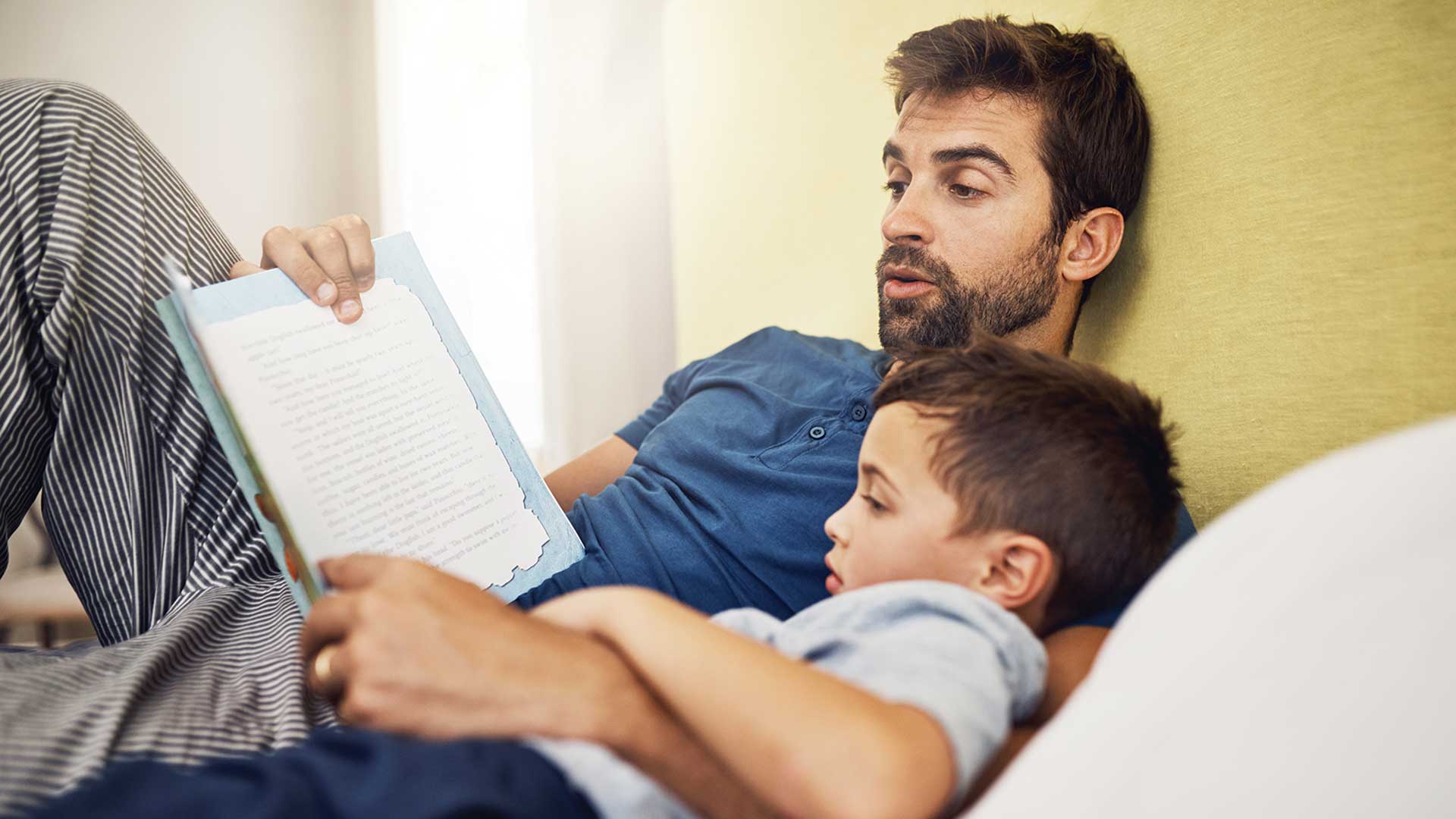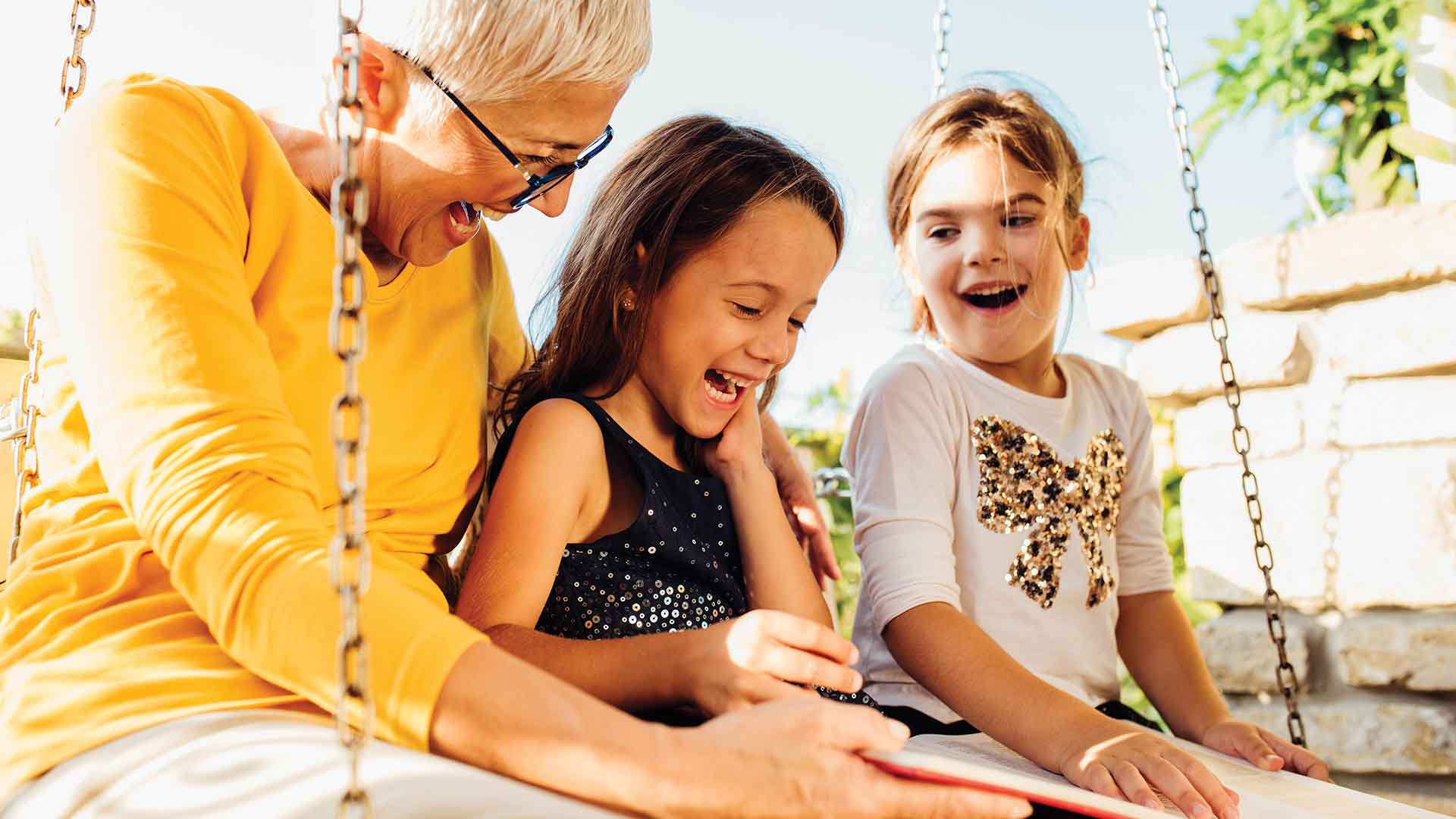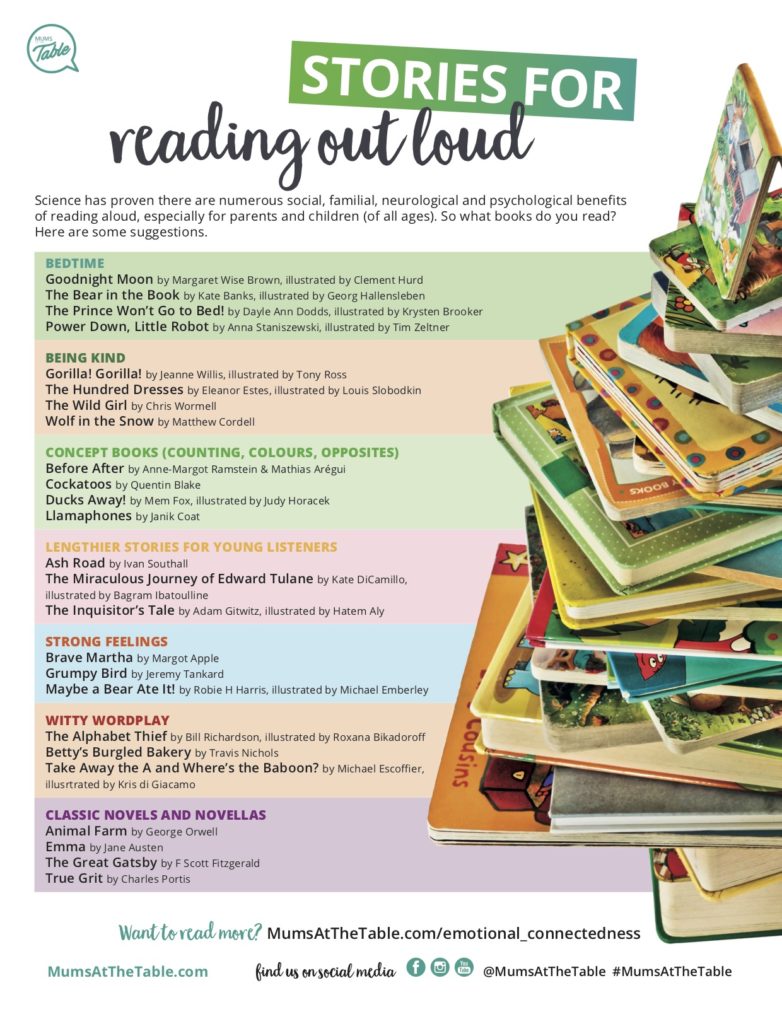There are numerous social, familial, neurological and psychological benefits of reading aloud. Here’s how to create the most treasured hour in the day for you and your kids.
What’s the most important reading aloud tip?
First, power down your technology. Silence your phones and, if you can, put them far enough away that you won’t see them or hear if they buzz. Give everyone the physical space to engage with the words and story, and with each other. Devices mess with our ability to be present in the moment, as we know; they also disrupt the development of joint attention and emotional connectedness.
A 2017 study, “Learning on Hold”, gives an unsettling glimpse of the degree to which mobile phones, in particular, tend to sidetrack parent-child interactions. Mums participating in the study were given the task of teaching their two-year-old children two words, one at a time. The women all had their mobile phones with them, and the clinicians made a point of interrupting half of the teaching sessions with a phone call.
“It rings. The mother picks it up. And she’s been engaged with the kid, and it’s like she’s breaking the set with the kid,” said the University of Delaware’s Roberta Michnick Golinkoff, a coinvestigator on the study. “And you know how you are when you answer the phone, your face goes flat? So her face goes flat, she looks away from the kid and then the kid doesn’t want to come back. Even though she gets off the phone and she repeats and repeats, and tries and tries, and the kid won’t learn the word.” When the mothers and children were interrupted, the children did not learn the words. When the pairs were left to themselves, without the interrupting call, the toddlers learned the new words.
For reading aloud to work its full magic, it’s best not to have competition from technology. So, yes, please, turn it off.
What if my “baby” is already in the fourth grade? Or sixth? Is it too late?
Never. While it’s probably too late to read baby books together, it is not too late to take baby steps toward a goal. Find 10 minutes on either side of dinner, say, or at bedtime, or at any point in the day when you and your child will naturally be in each other’s company. Again, start small. You could try reading a poem or a news story, or maybe something your child has been assigned (or has already read) at school. Do the same thing at roughly the same time for 10 minutes the next day, and build from there. If you never progress beyond 10 minutes, so be it. But you’ll still have built a lovely point of engagement into each day. Even worldly Year Six students like to have warm, positive attention from their parents.
How am I going to get my kids to pay attention?

Try to enjoy yourself. The more you enter into the reading, the more persuasive your example. It helps to have a great book, of course, but reading aloud is a complex and bountiful experience. The story you select is only one of the ingredients. You are another and then there’s your child, with their mind lit up and their senses engaged in listening, and perhaps looking at the illustrations. (Or they may be across the room playing with Lego or drawing with markers while you read—that’s fine, too.)
Entering into storytelling mode has a mesmeric power of its own. The sight of a parent or teacher sitting down with a book attracts young children like iron filings to a magnet. There is no absolute need for theatrics. All you have to do is let the words unspool. Sentence by sentence, they will cast the spell.
Having said that, it is also true that the more invested you are as a reader, the more persuasive the experience will be for everyone. Silly voices and comic accents can add a lot to the pleasure.
Reading can also take on an element of adventure by changing the location. One father read seafaring books while he and his kids were crammed in “belowdecks” on the bottom tier of a bunk bed.
But my kids are years apart in age. Are they supposed to listen to me read the same books at the same time?
Why not? Maybe. It depends. You may need to experiment to find what suits your particular basket of personalities. Whether you read to everyone at once, or to each in turn, also may evolve with time.
Over the years, I’ve catered to all sorts of age configurations. There were jolly times when everyone piled in together and we’d read a stack of picture books and then a chapter or two of a longer story for an hour before bed.
Everyone got what they needed: the familiarity, reassurance and visual pleasure of picture books (which older children like, too), along with the vocabulary- and imagination-stretching of chapter books that required the children to create scenes in their own heads.
We had one intense span of time, lasting maybe two years, when I’d spend 45 minutes reading picture books to my younger children, and then go downstairs to read Kidnapped, Treasure Island, The Swiss Family Robinson and 20,000 Leagues Under the Sea to the older two for another 45 minutes.
Is it best to read in the evenings?
You should read whenever it feels right. If you’re at home all day when your children are small, there may be lots of odd, random moments when you could pick up a book. If you’re working outside the home, it may be easier in the early years to piggyback reading onto other hands-on activities, such as during breakfast or at bath time.
As children get older, bedtime is usually best for corralling purposes. That’s what worked for my family. After the chaos of dinner and the maelstrom of getting children bathed, brushed and into pyjamas, to reach the story hour did feel like crawling onto a life raft. The seas were rocking, everyone was still a bit damp and windblown, but we were safe and there was a heavenly feeling of rescue and recovery.
I guess you didn’t have much of a social life.

No, it was fine! If I had to work after dinner, or if my husband and I had plans, I’d read while the children ate an early supper. But it does take sacrifice, there’s no getting around it. Considering the good that comes out of reading aloud, I’d say it’s cheap. Naturally there were times when we only read a couple of picture books or it was so late that I turned off the lights, saying, “The movie was your story tonight.”
I may be a zealot, but I’m no saint.
Does it matter who reads aloud? Does it make a difference for kids whether a man or a woman is reading to them?
No and yes. The great thing is for children to have reading time, and the more voices, the merrier. Usually the person who likes reading aloud the most—the thwarted thespian, for instance (ahem), who has no other outlet for goofy voices—will take the lead.
Academic research suggests that men and women tend to bring different qualities to read-aloud time, though I’m told that the variation between people as individuals is probably far greater and more meaningful than those between the sexes. Researchers at NYU have observed that fathers tend to talk more with children about maths and numbers. When sharing picture books, for instance, they’re more inclined to ask a child to count the blocks or teddy bears. Mothers and fathers both give children lots of cognitive stimulation when they’re reading, but their emphases may differ.
Reading can also be the one time in a day that the busier parent has a chance to bond with the child, or children, in a quiet time set aside for themselves.
What may start as an obligation can become the most treasured hour in the day.
My kids never sit still. How am I supposed to read to them?
This is tricky and there’s not a short answer. Some children may seem to signal boredom and indifference when in fact they are wide awake and paying attention. Other kids find it hard to focus, or dislike being confined on a lap. They may wrest themselves away from a restraining arm. These children may only be able to enjoy the reading experience if they’re given space to move. For a grown-up this can feel like rejection, which is unfortunate.
So it’s worth remembering that there is no “correct” way to read aloud. Given the amazing benefits, we need to make accommodations for all kinds of personalities. Children are people too, as someone said. They vary in the kinds of stories they enjoy, in their desire to be held or touched, and in the amount of landscape description they can tolerate.
A more delicate decision arises when a child seems to prefer the screen to any other company or entertainment.
Extracted from The Enchanted Hour: The Miraculous Power of Reading Aloud in the Age of Distraction by Meghan Cox Gurdon, published by Hachette Australia. Out now. A$32.99 | NZ$34.99.
Free printable: Read-aloud book list
Simple click on the image or link below to download the list to print out.

How helpful was this article?
Click on a star to rate it!
0 / 5. 0
Be the first to rate this post!
Meghan Cox Gurdon
Related posts
Subscribe
Receive personalised articles from experts and wellness inspiration weekly!

